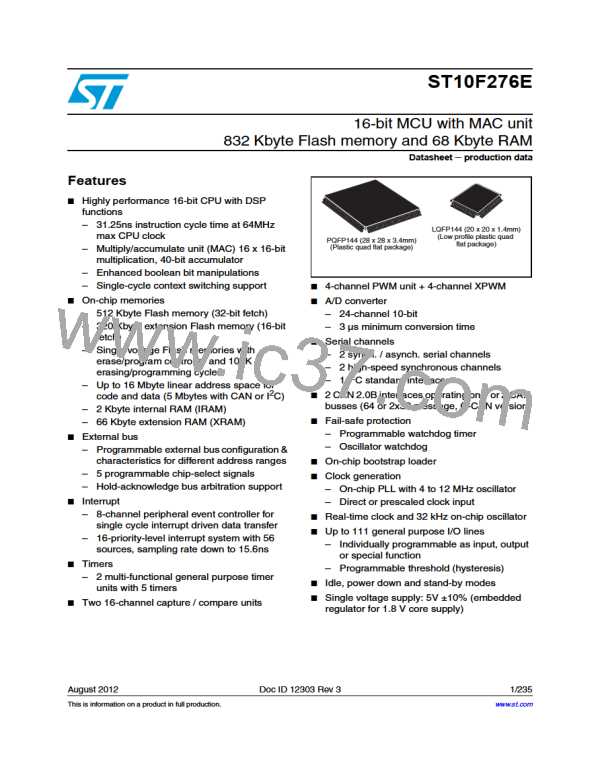Bootstrap loader
ST10F276E
5.5
Comparing the old and the new bootstrap loader
Table 33 and Table 34 summarize the differences between the old ST10 (boot via UART
only) bootstrap and the new one (boot via UART or CAN).
5.5.1
Software aspects
As the CAN1 is needed, XPERCON register is configured by the bootstrap loader code and
bit XPEN of SYSCON is set. However, as long as the EINIT instruction is not executed (and
it is not in the bootstrap loader code), the settings can be modified. To do this, perform the
following steps:
1. Disable the XPeripherals by clearing XPEN in SYSCON register. Attention: If this part
of the code is located in XRAM, it will be disabled.
2. Enable the needed XPeripherals by writing the correct value in XPERCON register.
3. Set XPEN bit in SYSCON.
Table 33. Software topics summary
Former bootstrap loader
New bootstrap loader
Comments
For compatibility between boot
via UART and boot via CAN1,
please avoid loading the
application software in the
00’FA60h/00’FABFh range.
Uses only 32 bytes in Dual-Port Uses up to 128 bytes in Dual-
RAM from 00’FA40h
Port RAM from 00’FA40h
Loads 32 bytes from UART
(boot via UART mode)
Same files can be used for boot
via UART.
Loads 32 bytes from UART
User selected Xperipherals can
User can change the
be enabled during boot (Step 3 Xperipherals selection is fixed. Xperipherals selections through
or Step 4).
a specific code.
5.5.2
Hardware aspects
Although the new bootstrap loader is designed to be compatible with the old bootstrap
loader, there are a few hardware requirements for the new bootstrap loader as summarized
in Table 34.
Table 34. Hardware topics summary
Former bootstrap loader
New bootstrap loader
Comments
P4.5 cannot be used as user
output in BSL mode, but only as
CAN1_RxD or input or address
segments.
P4.5 can be used as output in
BSL mode.
-
Level on CAN1_RxD can
change during boot Step 2.
Level on CAN1_RxD must be
stable at ‘1’ during boot Step 2. needed.
External pull-up on P4.5
66/235
Doc ID 12303 Rev 3

 STMICROELECTRONICS [ ST ]
STMICROELECTRONICS [ ST ]